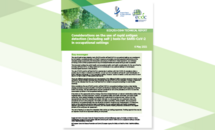Considerations on the use of rapid antigen detection (including self-) tests for SARS-CoV-2 in occupational settings
This document outlines the public health considerations for the use of rapid antigen detection tests (RADTs), including self-test RADTs to detect SARS-CoV-2 in individuals in occupational settings in the European Union/European Economic Area (EU/EEA), and provides information on the use of such tests in an occupational safety and health at work context.
Executive summary
Key messages
The use of rapid antigen detection tests (RADTs) and/or self-test RADTs in occupational settings can complement, but not replace, occupational safety and health measures and existing non-pharmaceutical interventions at the workplace aimed at preventing the introduction and spread of SARS-CoV-2. Most importantly, any individual exhibiting COVID-19-like symptoms should stay at home/self-isolate and access testing as soon as possible.
This document outlines the public health and occupational safety and health considerations for the use of RADTs, including self-test RADTs, to detect SARS-CoV-2 in individuals in occupational settings in the European Union/European Economic Area (EU/EEA).
The use of RADTs and/or self-test RADTs is appropriate in settings with high COVID-19 prevalence when a positive result is likely to indicate true infection, as well as in low prevalence settings for rapid identification of highly infectious individuals. In a low prevalence setting, however, caution is needed, as the use of RADTs could result in a high number of false positive test results.
There are different legal frameworks and requirements in the different EU/EEA countries concerning testing in the workplace. Several EU/EEA countries have introduced the use of RADTs at the workplace. However, a recent EU-OSHA survey indicates that the use of self-test RADTs is limited in occupational settings in most EU/EEA countries.
When considering the use of RADTs and/or self-test RADTs in occupational settings, having a clear testing strategy promotes occupational safety and health and facilitates meeting the public health objectives of testing. Within the strategy, the test performance must be considered as well as the prevalence of COVID-19 and the transmission dynamics in the occupational setting at hand.
Discussions on the appropriate testing strategy should be initiated between all relevant stakeholders before their implementation, including employers, workers, occupational safety and health authorities, and public health authorities. When testing strategies are designed and implemented at enterprise level, workers (or their representatives) should be consulted and clearly informed, in a language they can understand, about the procedures set out in the enterprise. The health and safety committee, where available, the occupational physicians or occupational health services should be involved in designing and implementing it. Furthermore, testing at the workplace should be clearly embedded in the occupational safety and health management approach according to the hierarchy of control, and the results of testing should be considered in the regular revision of the workplace risk assessment.
The cost of testing is an issue for enterprises when setting up testing programmes. Funding opportunities may be an important incentive to implement testing at workplaces.








